-
 Making WavesGiclee on Canvas Mural
Making WavesGiclee on Canvas Mural- 57.25"h
- 126"w
- 1.25"d
$7,000 Canadian -
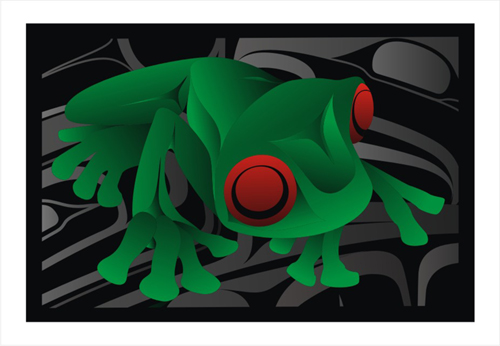 Skookum’s Dream IILimited Edition Giclee
Skookum’s Dream IILimited Edition Giclee- 13.13"h
- 19.75"w
$200 Canadian -
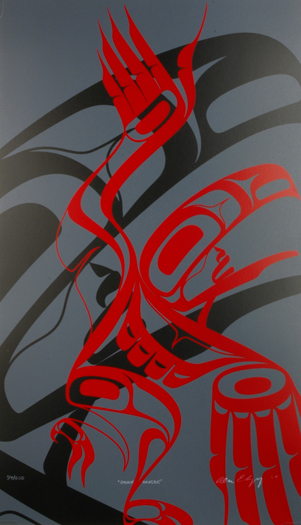 Raven DancerLimited Edition Serigraph
Raven DancerLimited Edition Serigraph- 21.5"h
- 12.5"w
$200 Canadian -
 Wise FrogLimited Edition Giclee
Wise FrogLimited Edition Giclee- 21.5"h
- 21.5"w
$220 Canadian -
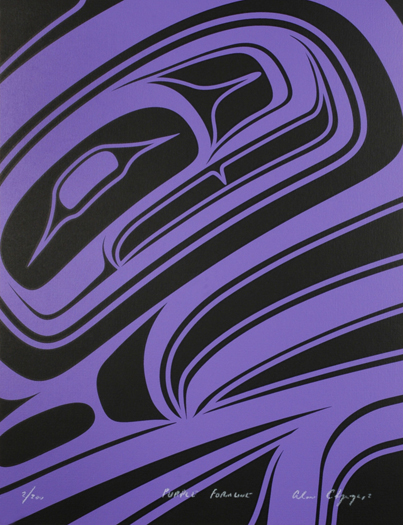 Purple FormlineSerigraph
Purple FormlineSerigraph- 16"h
- 12"w
$130 Canadian -
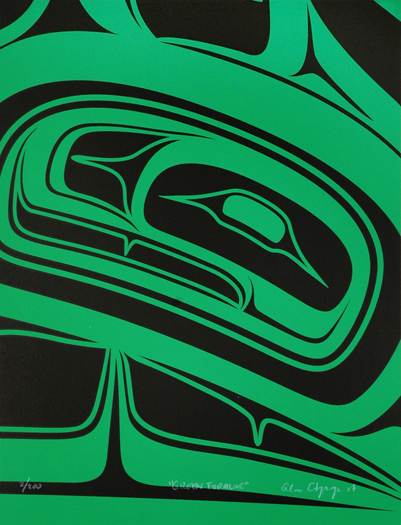 Green FormlineSerigraph
Green FormlineSerigraph- 16"h
- 12"w
$130 Canadian -
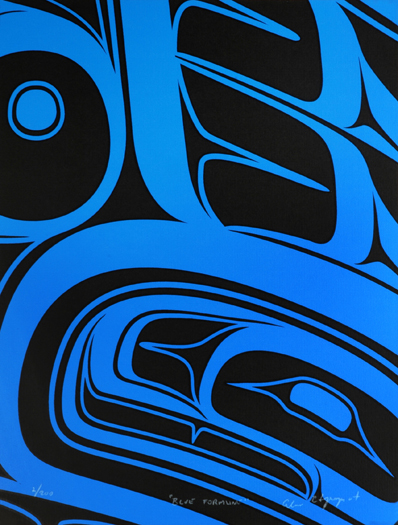 Blue FormlineSerigraph
Blue FormlineSerigraph- 15.87"h
- 12"w
$130 Canadian -
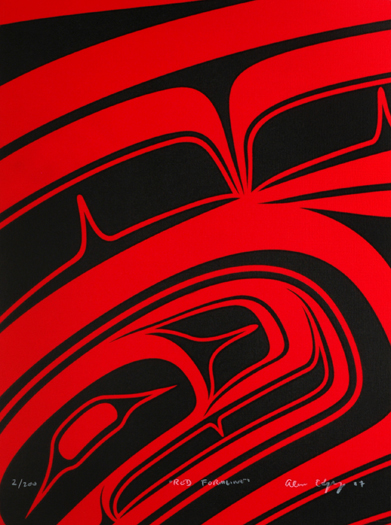 Red FormlineSerigraph
Red FormlineSerigraph- 16"h
- 12"w
$130 Canadian -
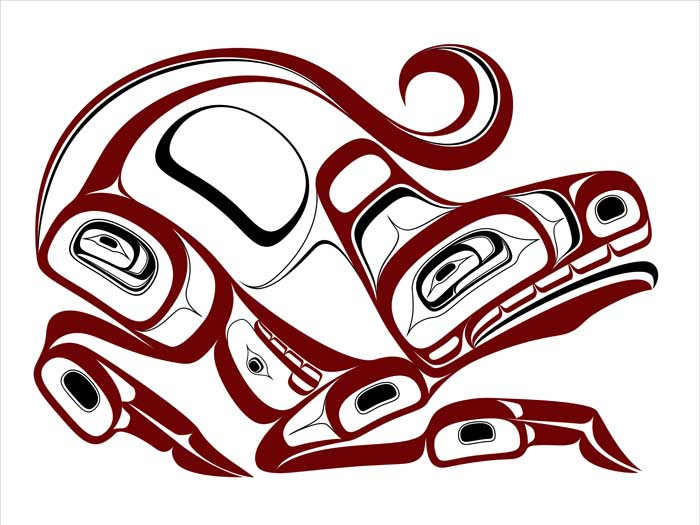 Cheona AlphaLimited Edition Giclee
Cheona AlphaLimited Edition Giclee- 20"h
- 27"w
$220 Canadian -
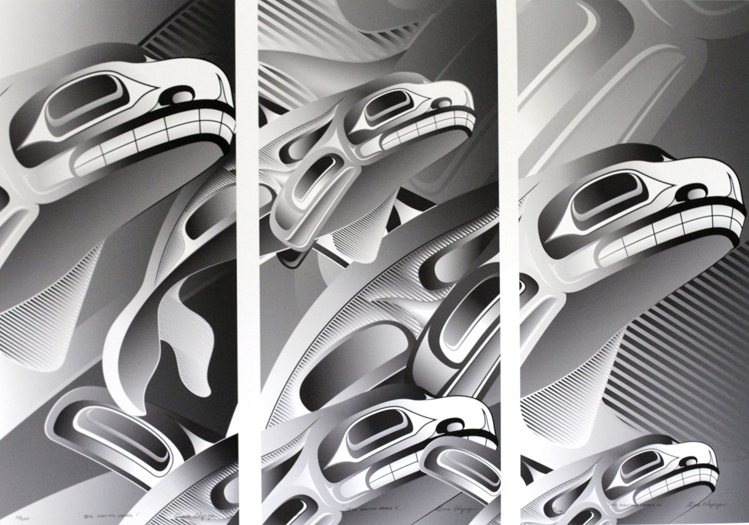 Still Making Waves TriptychLimited Edition Giclee, Set of 3
Still Making Waves TriptychLimited Edition Giclee, Set of 3- 29.5"h
- 14.5 each"w
$600 Canadian -
Kaleidoscope Butterfly TriptychLimited Edition Giclee, Set of 3$600 Canadian
-
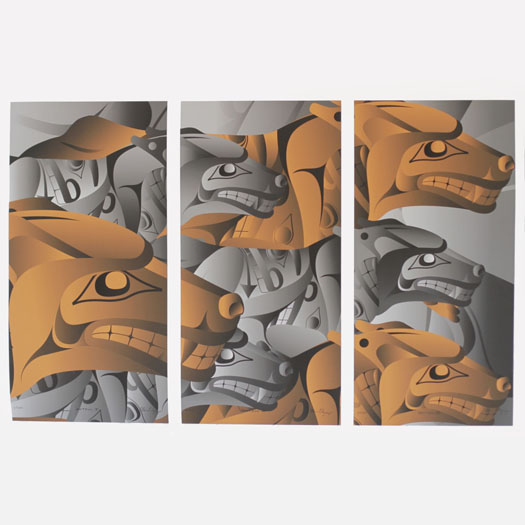 Hunting TriptychLimited Edition Giclee, Set of 3
Hunting TriptychLimited Edition Giclee, Set of 3- 27"h
- 13"w
$600 Canadian -
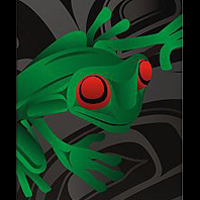 Skookum’s Dream ILimited Edition Giclee
Skookum’s Dream ILimited Edition Giclee- 23.38"h
- 19.25"w
$250 Canadian -
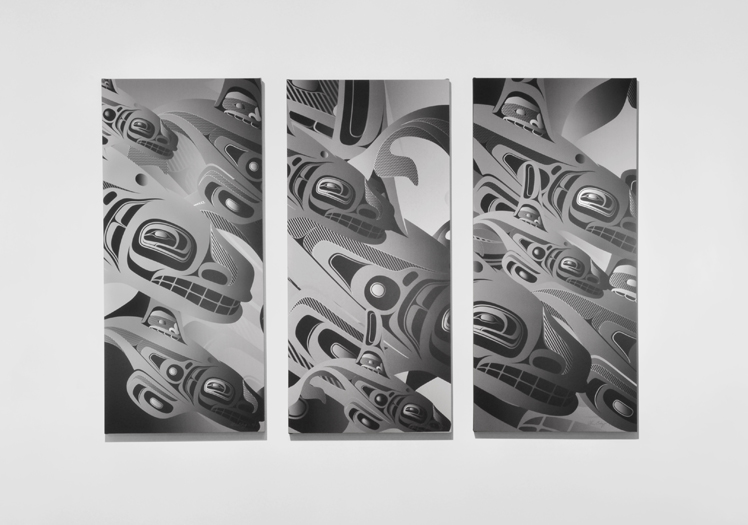 Strength Triptych3 Stretched Canvas Giclee Prints
Strength Triptych3 Stretched Canvas Giclee Prints
dimensions below are for each canvas- 60"h
- 30"w
- 2"d
$4,500 Canadian -
 Birth of the Beaver ClanLimited Edition Giclee
Birth of the Beaver ClanLimited Edition Giclee- 24.75"h
- 20"w
$250 Canadian -
 The Gift of the Raven I & IILimited Edition Giclees
The Gift of the Raven I & IILimited Edition Giclees- 24"h
- 14.5"w
$200 Canadian each -
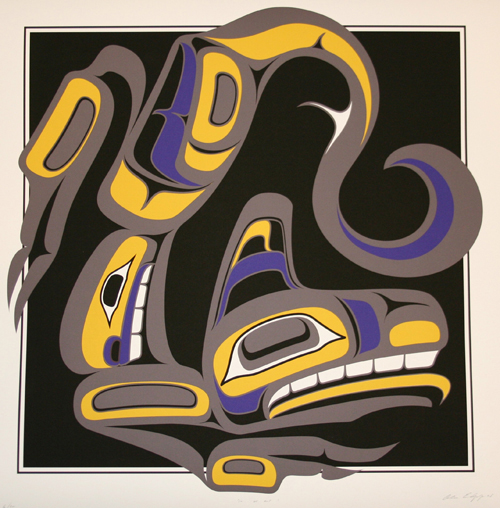 In or OutLimited Edition Giclee
In or OutLimited Edition Giclee- 22.75"h
- 22"w
$250 Canadian -
 Salmon PeopleLimited Edition Giclee
Salmon PeopleLimited Edition Giclee- 14.25"h
- 31"w
$300 Canadian -
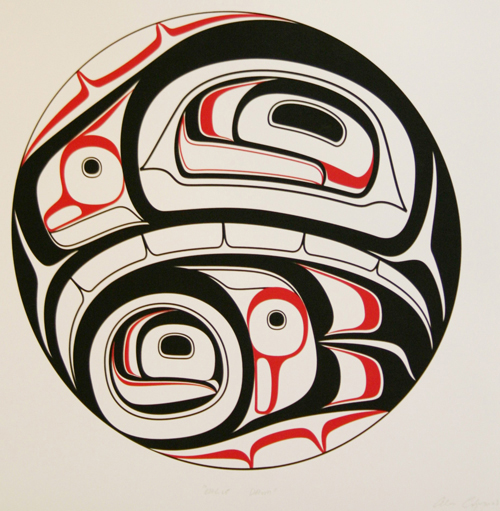 Eagle DrumLimited Edition Giclee
Eagle DrumLimited Edition Giclee- 14.88"h
- 14.63"w
$100 Canadian -
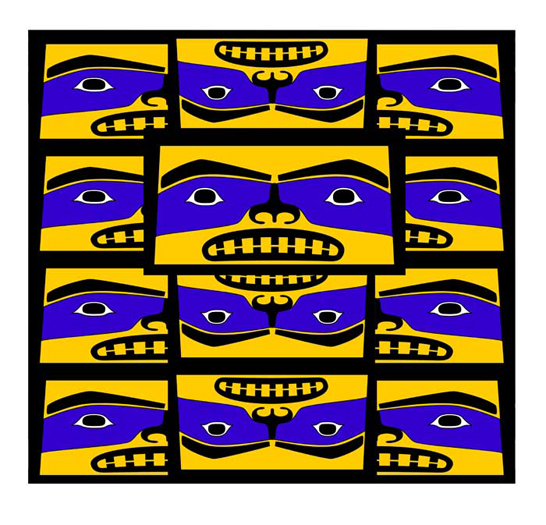 Born LeaderLimited Edition Giclee
Born LeaderLimited Edition Giclee- 21.75"h
- 24"w
$220 Canadian -
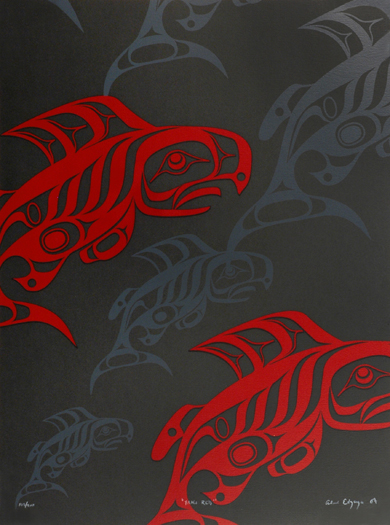 Taku RedSerigraph
Taku RedSerigraph- 21.5"h
- 16.25"w
$240 Canadian -
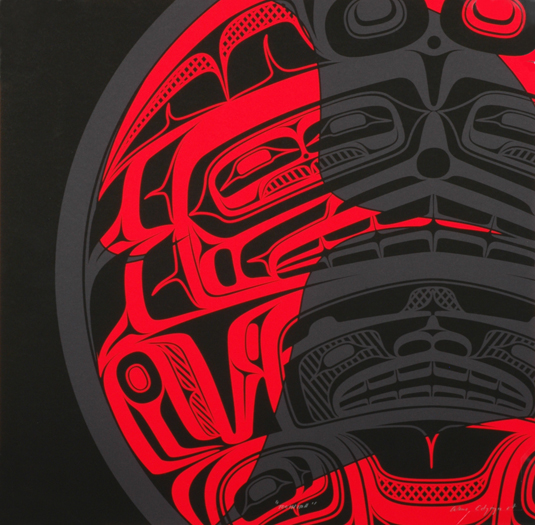 Tooth-TahLimited Edition Giclee
Tooth-TahLimited Edition Giclee- 17"h
- 18"w
$240 Canadian -
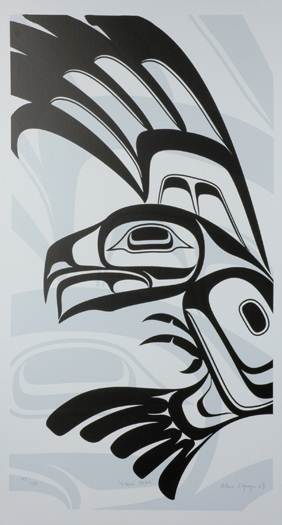 Eagle StrikeSerigraph
Eagle StrikeSerigraph- 23"h
- 12"w
$200 Canadian -
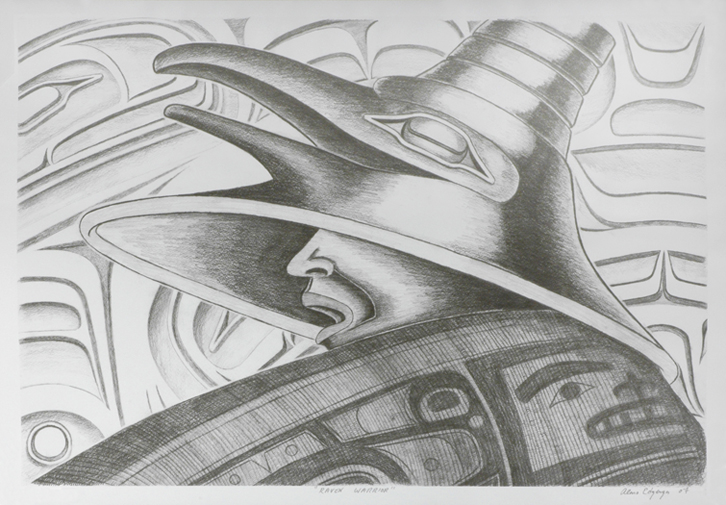 Raven WarriorLimited Edition Giclee
Raven WarriorLimited Edition Giclee- 15.75"h
- 21.25"w
$200 Canadian -
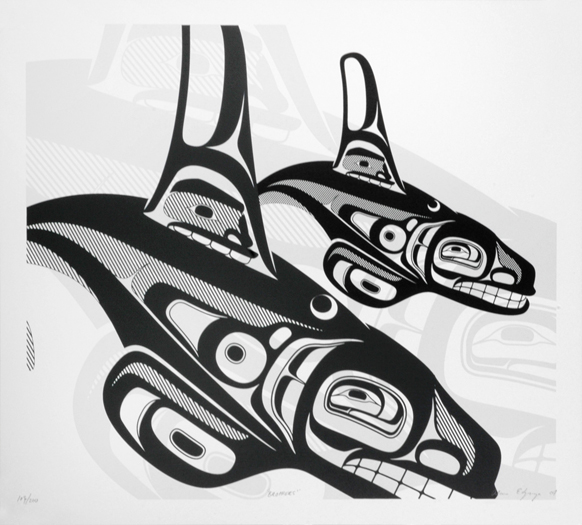 BrothersSerigraph
BrothersSerigraph- 15.25"h
- 17.5"w
$200 Canadian -
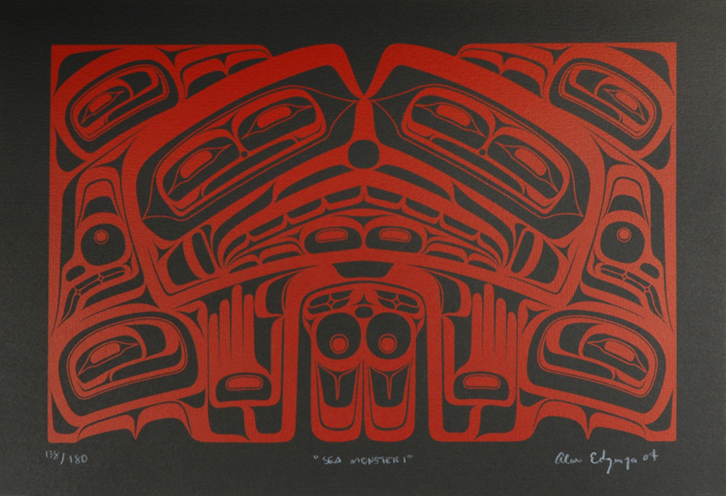 Sea Monster ISerigraph
Sea Monster ISerigraph- 11.5"h
- 16.5"w
$80 Canadian -
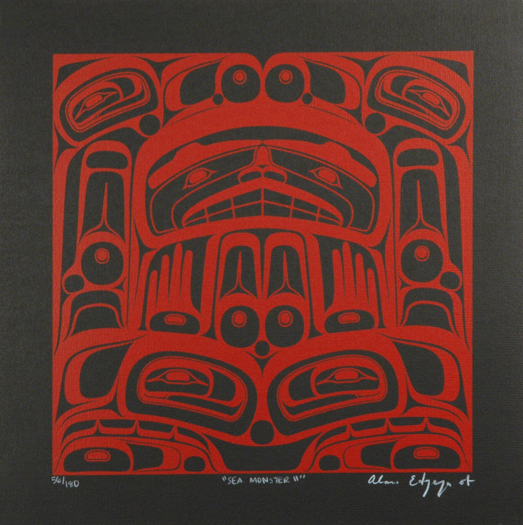 Sea Monster IISerigraph
Sea Monster IISerigraph- 11.25"h
- 11.25"d
$80 Canadian -
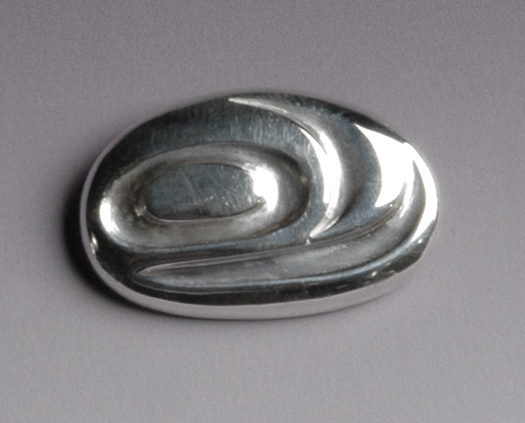 Salmon PendantCast Sterling Silver
Salmon PendantCast Sterling Silver- .5"h
- .75"w
$70 Canadian -
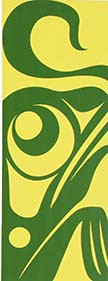 Tree FrogLimited Edition Giclee
Tree FrogLimited Edition Giclee- 27.5"h
- 10.5"w
$150 CAD -
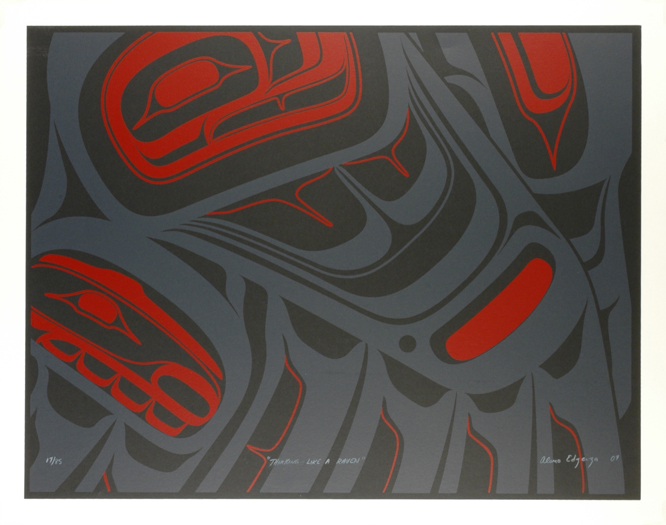 Thinking Like a RavenSerigraph
Thinking Like a RavenSerigraph- 19.5"h
- 25"w
$290 Canadian -
 Sea Monster IIISerigraph
Sea Monster IIISerigraph- 11.5"h
- 16.25"w
$80 Canadian -
 Copper MoonLimited Edition Giclee
Copper MoonLimited Edition Giclee- 21.25"h
- 5.5"w
$90 Canadian -
 Taku Transformer I/IILimited Edition Sandblasted Glass, Plywood, Acrylic, Stainless Steel Standoffs
Taku Transformer I/IILimited Edition Sandblasted Glass, Plywood, Acrylic, Stainless Steel Standoffs- 43"h
- 31"w
- 3"d
-
 Taku Transformer II/IILimited Edition Sandblasted Glass, Plywood, Acrylic, Stainless Steel Standoffs
Taku Transformer II/IILimited Edition Sandblasted Glass, Plywood, Acrylic, Stainless Steel Standoffs- 43"h
- 31"w
- 3"d
-
 Bear DenLimited Edition Giclee
Bear DenLimited Edition Giclee- 22"h
- 22"w
SOLD -
 Red EagleLimited Edition Giclee
Red EagleLimited Edition Giclee- 27.5"h
- 10.5"w
SOLD -
 Electric RavenLimited Edition Giclee
Electric RavenLimited Edition Giclee- 27.5"h
- 10.5"w
SOLD -
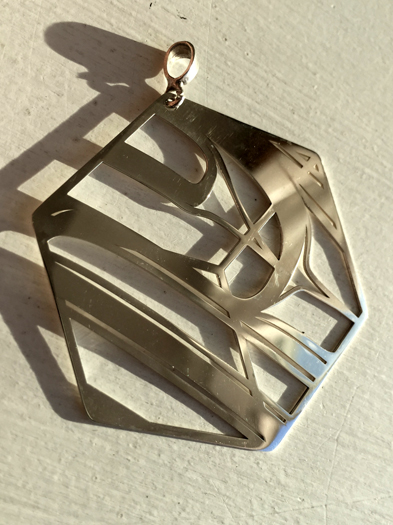 Medium Cube PendantOpen Edition Sterling SilverSOLD
Medium Cube PendantOpen Edition Sterling SilverSOLD -
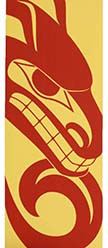 Copper WolfLimited Edition Giclee
Copper WolfLimited Edition Giclee- 27.5"h
- 10.5"w
SOLD -
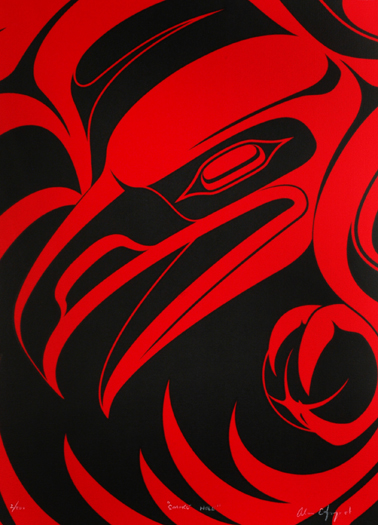 Smoke HoleSerigraph
Smoke HoleSerigraph- 19.75"h
- 14.12"w
SOLD -
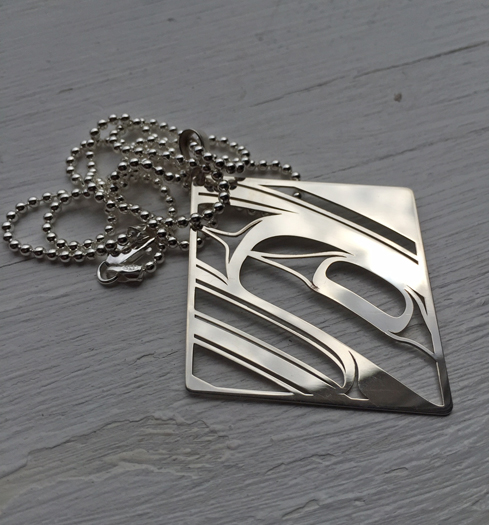 Medium Diamond PendantOpen Edition Sterling SilverSOLD
Medium Diamond PendantOpen Edition Sterling SilverSOLD -
 Killerwhale Mural – Panel IV/IVOpen Edition Red Cedar, Acrylic
Killerwhale Mural – Panel IV/IVOpen Edition Red Cedar, Acrylic- 80"h
- 41.13"w
- 1.38"d
SOLD -
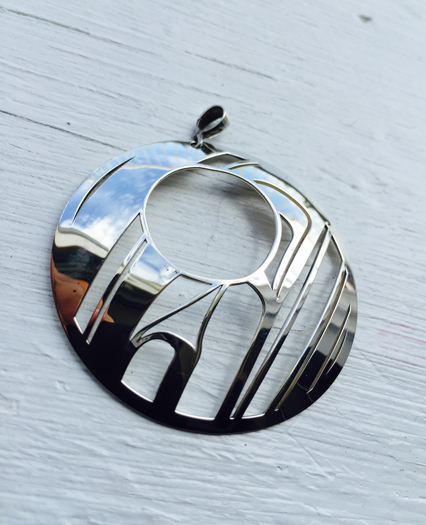 Medium Circle PendantOpen Edition Sterling SilverSOLD
Medium Circle PendantOpen Edition Sterling SilverSOLD -
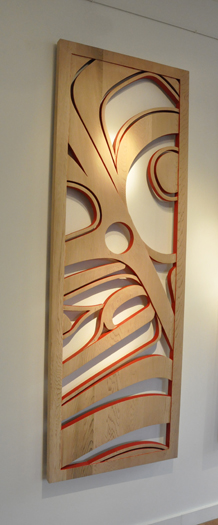 Killerwhale Mural – Panel I/IVOpen Edition Red Cedar, Acrylic
Killerwhale Mural – Panel I/IVOpen Edition Red Cedar, Acrylic- 80"h
- 28.13"w
- 1.38"d
SOLD -
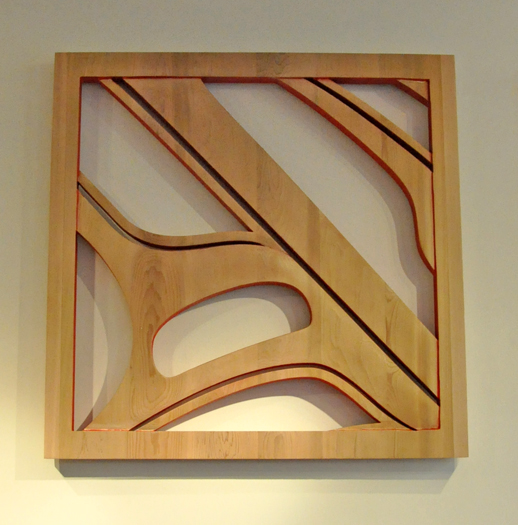 Killerwhale Mural – Panel II/IVOpen Edition Red Cedar, Acrylic
Killerwhale Mural – Panel II/IVOpen Edition Red Cedar, Acrylic- 34.63"h
- 34.63"w
- 2.38"d
SOLD -
_0.jpg) Killerwhale Mural – Panel III/IVOpen Edition Red Cedar, Acrylic
Killerwhale Mural – Panel III/IVOpen Edition Red Cedar, Acrylic- 34.63"h
- 34.63"w
- 2.38"d
SOLD -
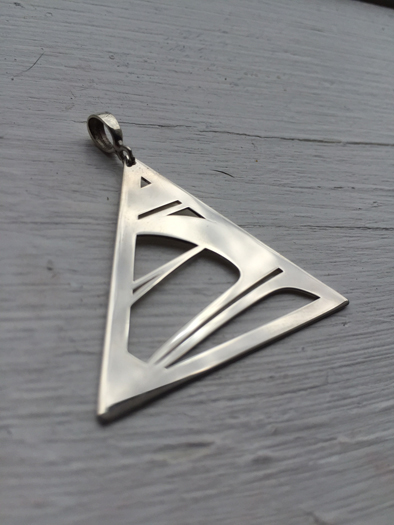 Medium Triangle PendantOpen Edition Sterling SilverSOLD
Medium Triangle PendantOpen Edition Sterling SilverSOLD -
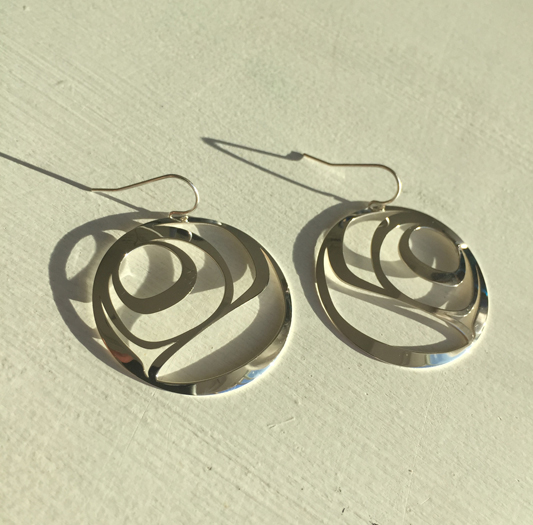 Small Salmon Egg EarringsOpen Edition Sterling SilverSOLD
Small Salmon Egg EarringsOpen Edition Sterling SilverSOLD -
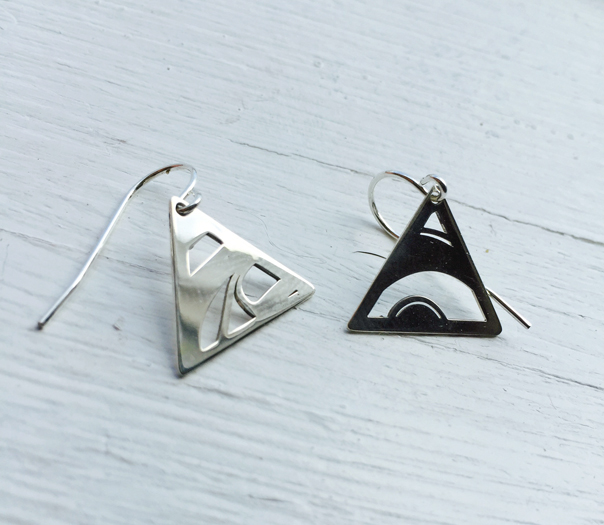 Small Triangle EarringsOpen Edition Sterling SilverSOLD
Small Triangle EarringsOpen Edition Sterling SilverSOLD -
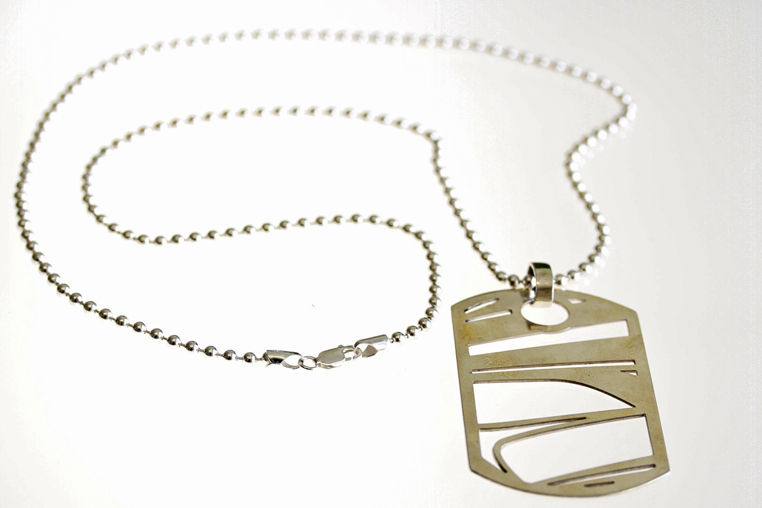 Medium Dog Tag PendantOpen Edition Sterling SilverSOLD
Medium Dog Tag PendantOpen Edition Sterling SilverSOLD -
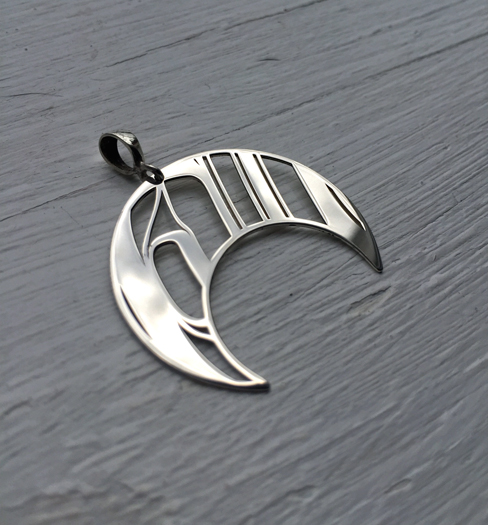 Medium Crescent PendantOpen Edition Sterling SilverSOLD
Medium Crescent PendantOpen Edition Sterling SilverSOLD -
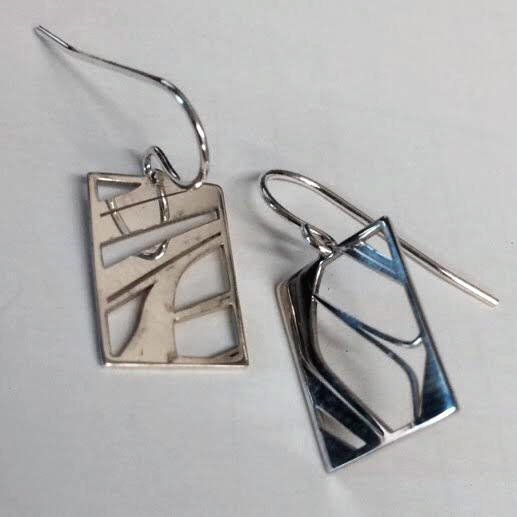 Small Rectangle EarringsOpen Edition Sterling SilverSOLD
Small Rectangle EarringsOpen Edition Sterling SilverSOLD -
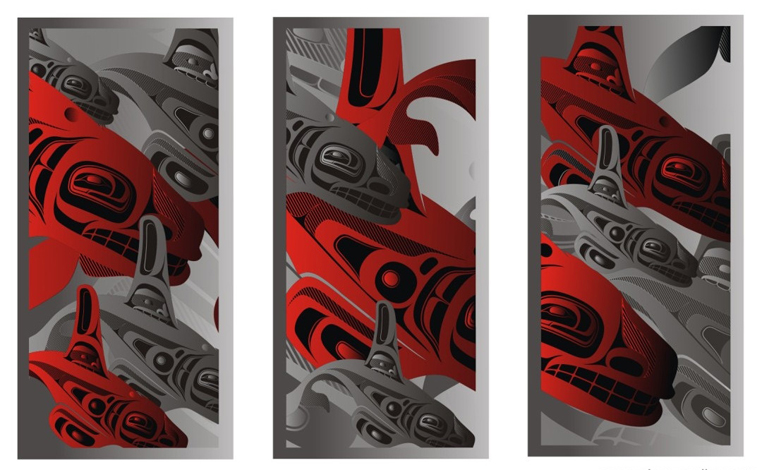 Making Waves TriptychLimited Edition Giclee, Set of 3
Making Waves TriptychLimited Edition Giclee, Set of 3- 30"h
- 14.5"w
SOLD -
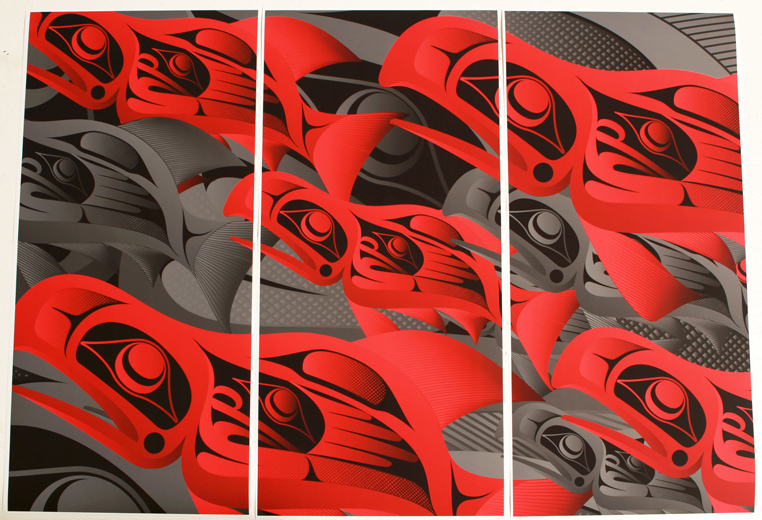 Stikine TriptychLimited Edition Giclee, Set of 3
Stikine TriptychLimited Edition Giclee, Set of 3- 31"h
- 15 each"w
SOLD -
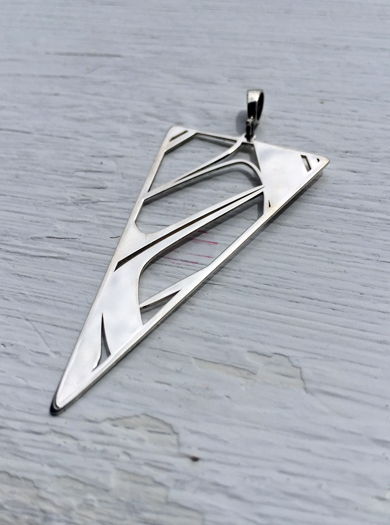 Medium Spearhead PendantOpen Edition Sterling SilverSOLD
Medium Spearhead PendantOpen Edition Sterling SilverSOLD -
 Formline Collar PendantOpen Edition Sterling SilverSOLD
Formline Collar PendantOpen Edition Sterling SilverSOLD -
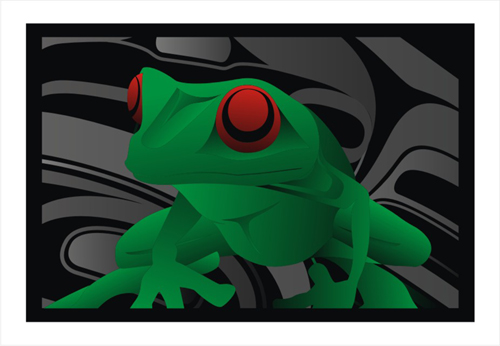 Skookum’s Dream IIILimited Edition Giclee
Skookum’s Dream IIILimited Edition Giclee- 13.13"h
- 19.75"w
SOLD -
 Raven DancerLimited Edition Sandblasted Glass, Red Cedar, Acrylic
Raven DancerLimited Edition Sandblasted Glass, Red Cedar, Acrylic- 39"h
- 18"w
- 3"d
SOLD -
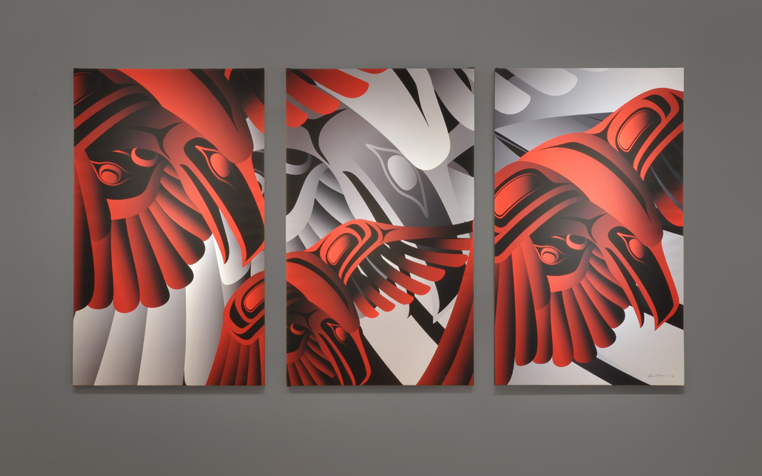 Gift of the Raven Triptych3 Stretched Canvas Giclee Prints
Gift of the Raven Triptych3 Stretched Canvas Giclee Prints- 59.5"h
- 35.25"w
- 1.5"d
SOLD -
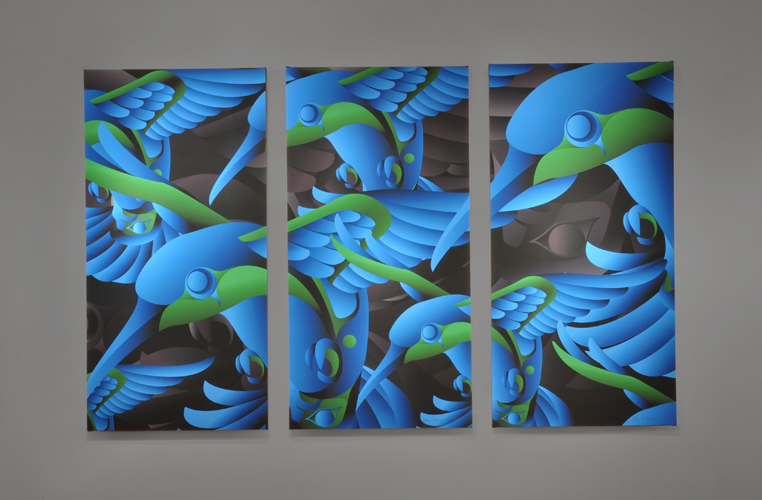 Charmed TriptychGiclee Print on Stretched Canvas.
Charmed TriptychGiclee Print on Stretched Canvas.- 48"h
- 24"w
SOLD -
 Thinking Like a RavenOriginal Acrylic Painting on Canvas
Thinking Like a RavenOriginal Acrylic Painting on Canvas- 36"h
- 48"w
SOLD -
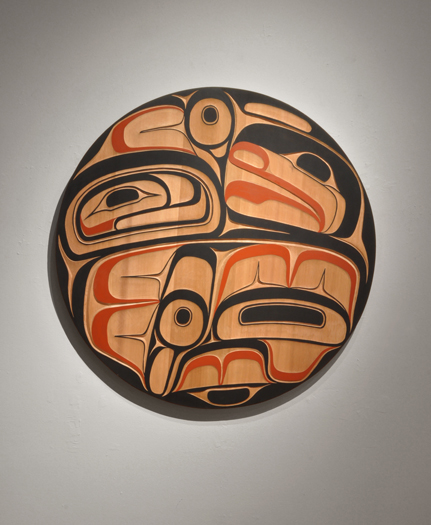 MosquitoRed Cedar, Acrylic
MosquitoRed Cedar, Acrylic- 36"h
- 36"w
- 1.5"d
SOLD -
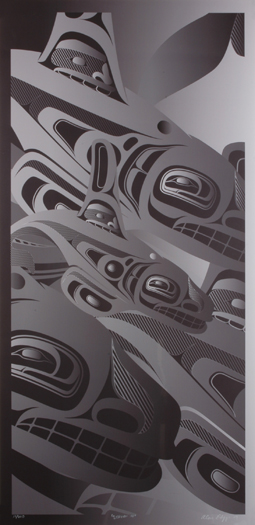 StrengthLimited Edition Giclee
StrengthLimited Edition Giclee- 29"h
- 14.25"w
SOLD -
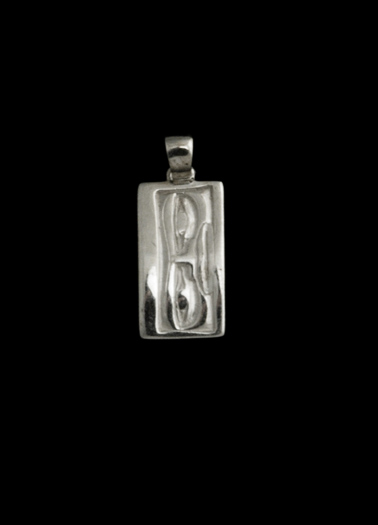 Chilkat PendantSterling SilverSOLD
Chilkat PendantSterling SilverSOLD -
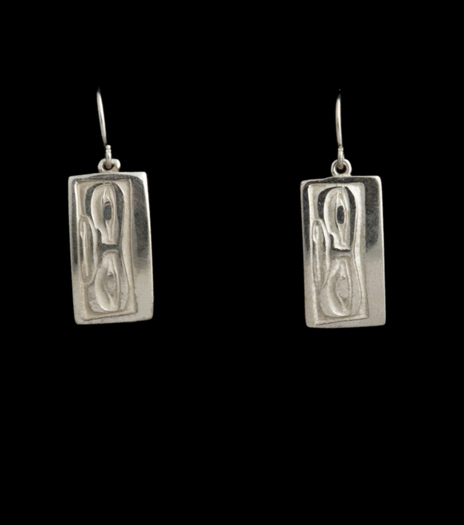 Chilkat Dangle EarringsSterling SilverSOLD
Chilkat Dangle EarringsSterling SilverSOLD -
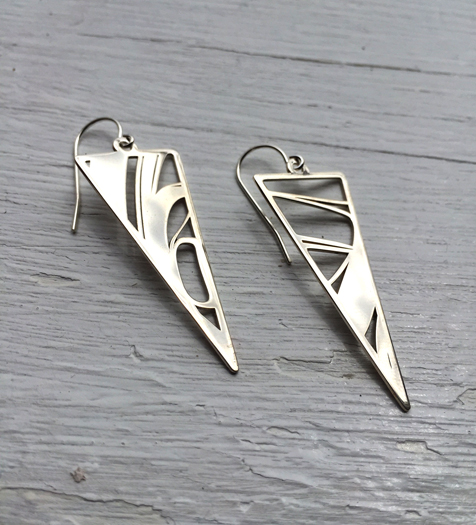 Medium Spearhead EarringsOpen Edition Sterling SilverSOLD
Medium Spearhead EarringsOpen Edition Sterling SilverSOLD -
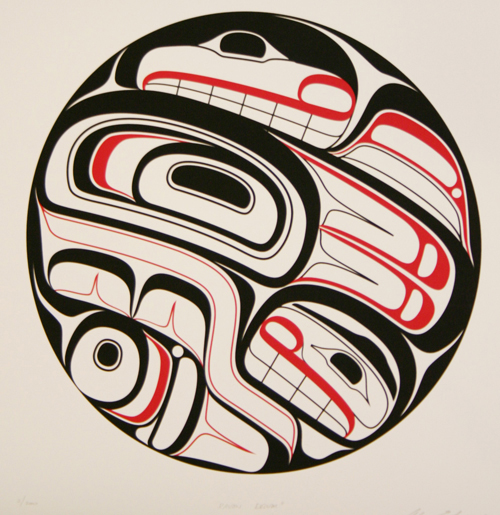 Raven DrumLimited Edition Giclee
Raven DrumLimited Edition Giclee- 14.88"h
- 14.63"w
SOLD -
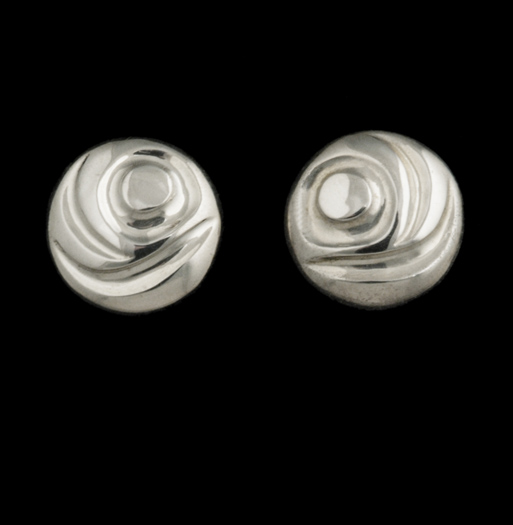 Salmon Post EarringsSterling SilverSOLD
Salmon Post EarringsSterling SilverSOLD -
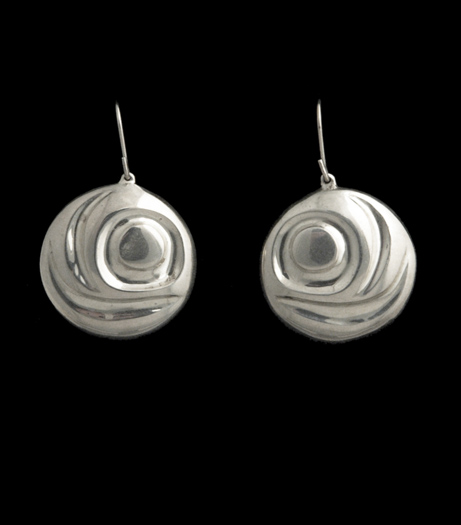 Salmon Dangle EarringsSterling SilverSOLD
Salmon Dangle EarringsSterling SilverSOLD -
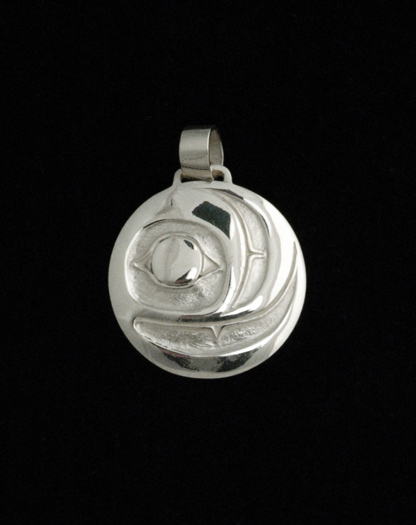 Salmon Roe PendantSterling SilverSOLD
Salmon Roe PendantSterling SilverSOLD -
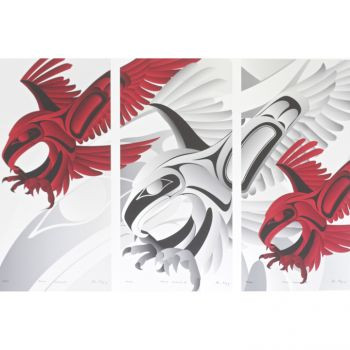 Eagle Landing TriptychLimited Edition Giclee, Set of 3
Eagle Landing TriptychLimited Edition Giclee, Set of 3- 28.25"h
- 13.5 each"w
SOLD -
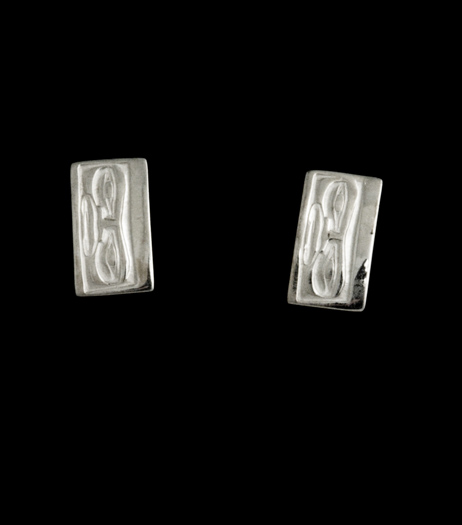 Chilkat Post EarringsSterling SilverSOLD
Chilkat Post EarringsSterling SilverSOLD -
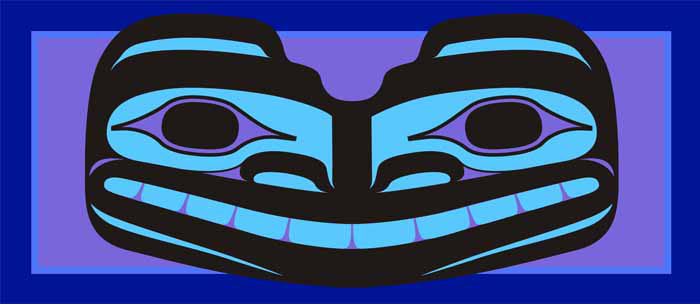 Electric PotlatchLimited Edition Giclee
Electric PotlatchLimited Edition Giclee- 9.13"h
- 21.63"w
SOLD -
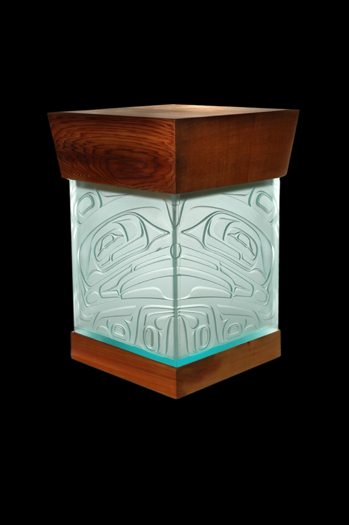 Chief of the Sea BoxSandblasted Glass, Red Cedar
Chief of the Sea BoxSandblasted Glass, Red Cedar- 15.5"h
- 12"w
- 12"d
SOLD -
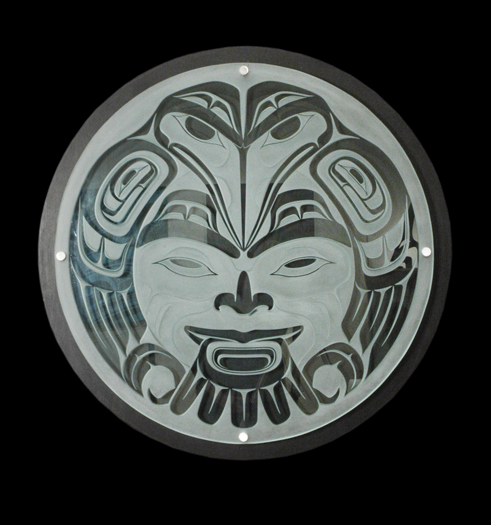 The Thief – PanelSandblasted Glass, Red Cedar, Acrylic, Stainless Steel
The Thief – PanelSandblasted Glass, Red Cedar, Acrylic, Stainless Steel- 36"h
- 36"w
- 4"d
SOLD -
 Tooth-TahSandblasted Glass, Red Cedar
Tooth-TahSandblasted Glass, Red Cedar- 28"h
- 28"w
- 4"d
SOLD -
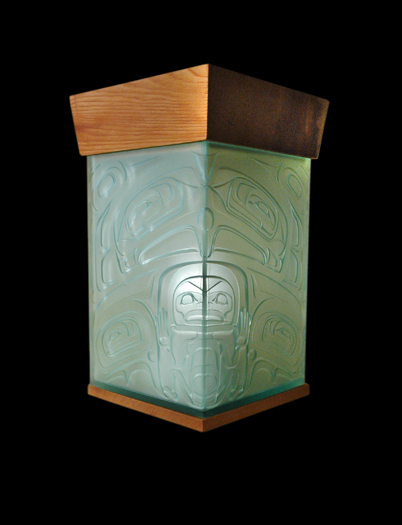 Two Eagles BoxSandblasted Glass, Red Cedar
Two Eagles BoxSandblasted Glass, Red Cedar- 18.75"h
- 11.5"w
- 11.5"d
SOLD -
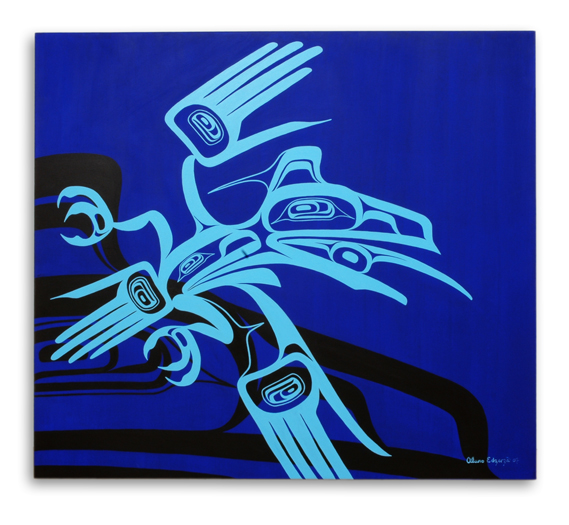 Moving ForwardAcrylic on Canvas
Moving ForwardAcrylic on Canvas- 36"h
- 36"w
- 1.5"d
SOLD -
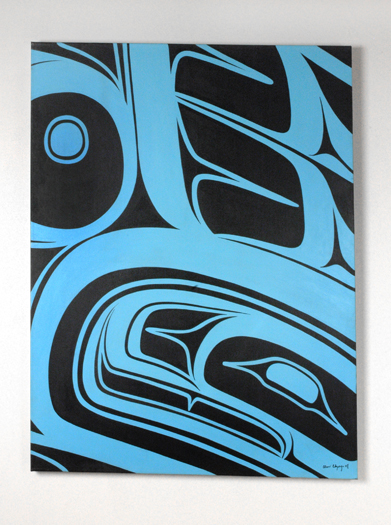 Formline Detail in BlueAcrylic on Canvas
Formline Detail in BlueAcrylic on Canvas- 48"h
- 36"w
- 1.5"d
SOLD -
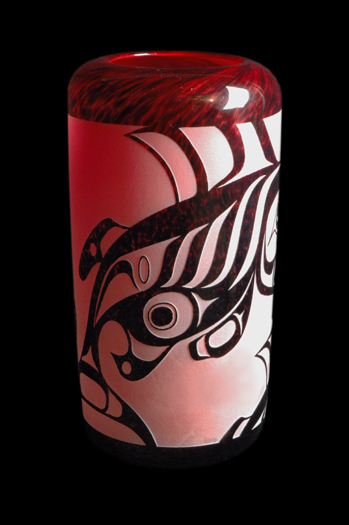 Taku RedSandblasted Glass
Taku RedSandblasted Glass- 13.25"h
- 6.75"w
- 6.75"d
SOLD -
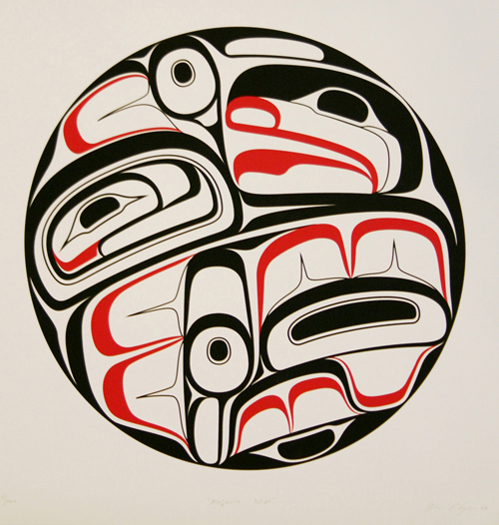 Mosquito DrumLimited Edition Giclee
Mosquito DrumLimited Edition Giclee- 14.88"h
- 14.63"w
SOLD -
 The Human Transformation Raven Transformation PanelLimited Edition Sandblasted Glass, Red Cedar, Acrylic, Stainless Steel
The Human Transformation Raven Transformation PanelLimited Edition Sandblasted Glass, Red Cedar, Acrylic, Stainless Steel- 61"h
- 28"w
- 3"d
SOLD -
 The ThiefLimited Edition Giclee
The ThiefLimited Edition Giclee- 21.5"h
- 21.5"w
SOLD -
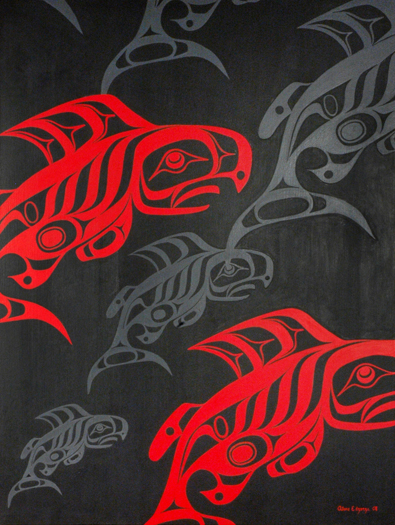 Taku RedAcrylic on Canvas
Taku RedAcrylic on Canvas- 48"h
- 36"w
- 1.5"d
SOLD -
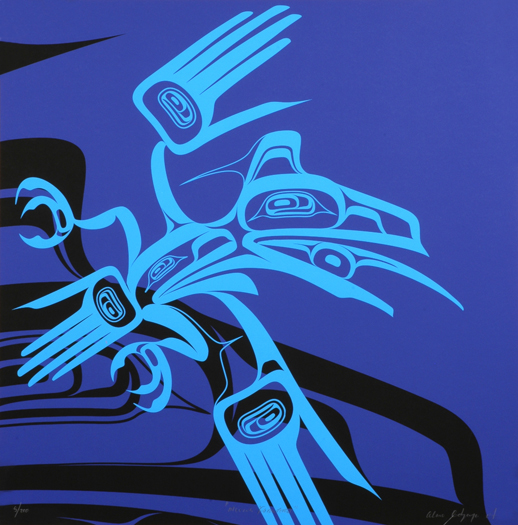 Moving ForwardLimited Edition Giclee
Moving ForwardLimited Edition Giclee- 18.5"h
- 18"w
SOLD -
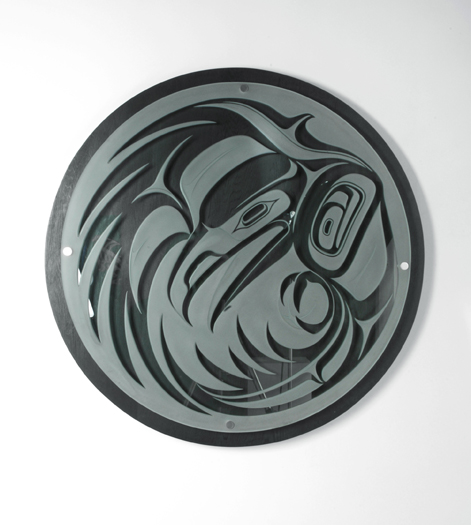 Smoke Hole PanelSandblasted Glass, Red Cedar, Acrylic, Stainless Steel
Smoke Hole PanelSandblasted Glass, Red Cedar, Acrylic, Stainless Steel- 36"h
- 36"w
- 4"d
SOLD -
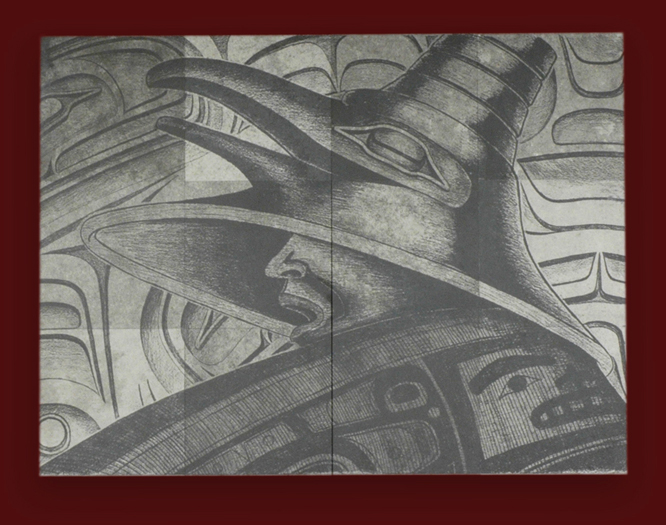 Raven WarriorEtched Slate
Raven WarriorEtched Slate- 36"h
- 48"w
- .75"d
SOLD -
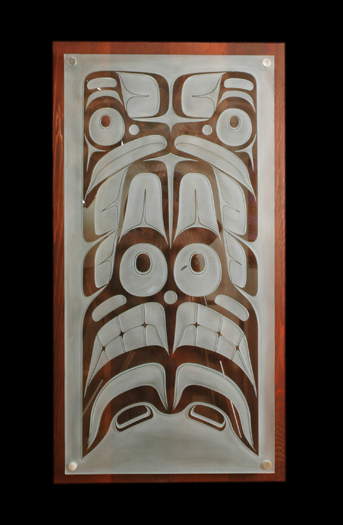 Variation of Mouse WomanSandblasted Glass, Red Cedar, Stainless Steel Standoffs
Variation of Mouse WomanSandblasted Glass, Red Cedar, Stainless Steel Standoffs- 42"h
- 22"w
- 3.5"d
SOLD -
 Eagle DancerSerigraph
Eagle DancerSerigraph- 21.5"h
- 12.25"w
SOLD -
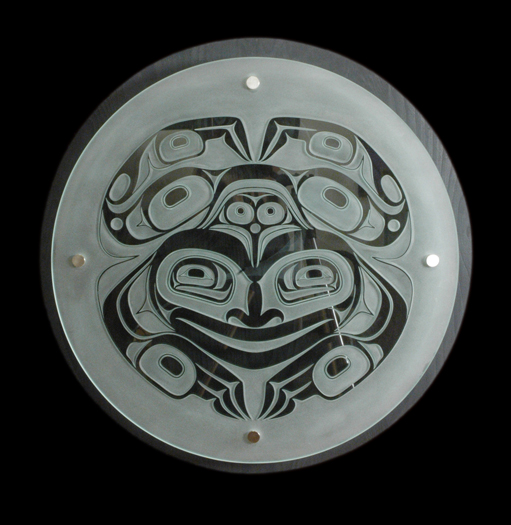 Wise Frog – PanelSandblasted Glass, Red Cedar, Acrylic, Stainless Steel
Wise Frog – PanelSandblasted Glass, Red Cedar, Acrylic, Stainless Steel- 26"h
- 26"w
- 2.5"d
SOLD -
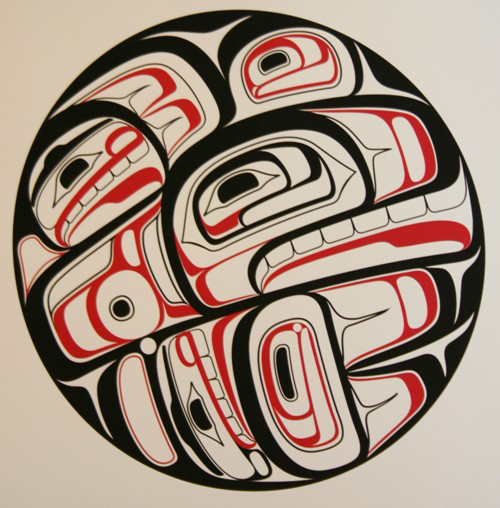 Killerwhale DrumLimited Edition Giclee
Killerwhale DrumLimited Edition Giclee- 14.88"h
- 14.63"w
SOLD -
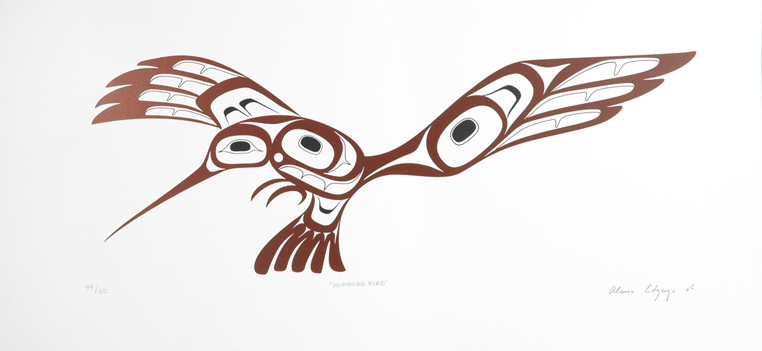 HummingbirdSerigraph
HummingbirdSerigraph- 12"h
- 24"w
SOLD -
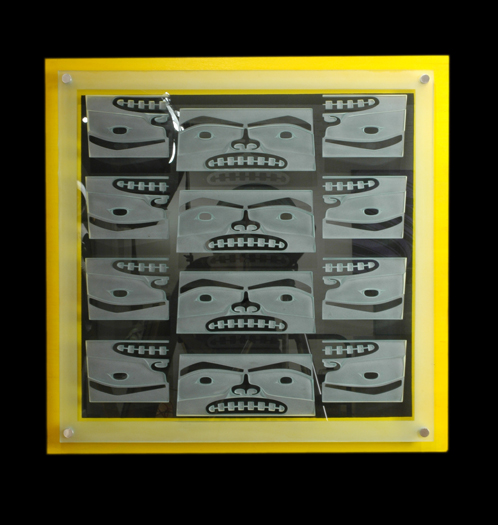 His Blanket of FacesSandblasted Glass, Red Cedar, Acrylic, Stainless Steel Standoffs
His Blanket of FacesSandblasted Glass, Red Cedar, Acrylic, Stainless Steel Standoffs- 32.5"h
- 33"w
- 3.5"d
SOLD -
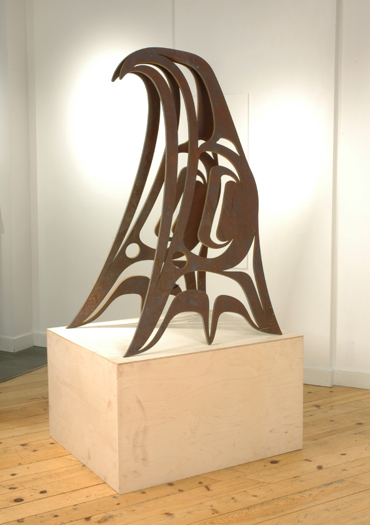 Coming Up1/2
Coming Up1/2- 60"h
- 28"w
- 36"d
SOLD -
 Raven and the First WomanSandblasted Glass, Red Cedar, Acrylic, Stainless Steel Standoffs
Raven and the First WomanSandblasted Glass, Red Cedar, Acrylic, Stainless Steel Standoffs- 60"h
- 27"w
- 4"d
SOLD -
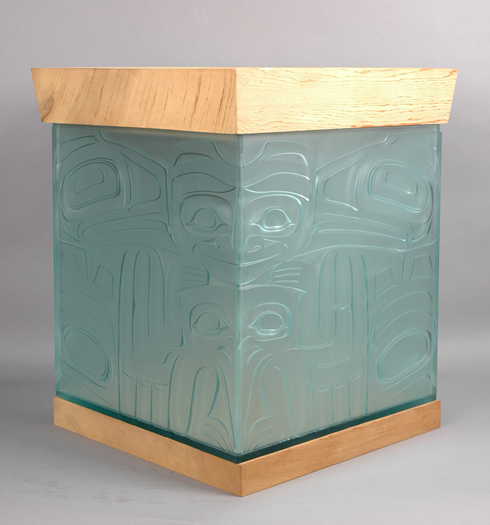 Raven and Bear BoxRed Cedar, Sandblasted Glass
Raven and Bear BoxRed Cedar, Sandblasted Glass- 21.5"h
- 17.75"w
- 17.75"d
SOLD -
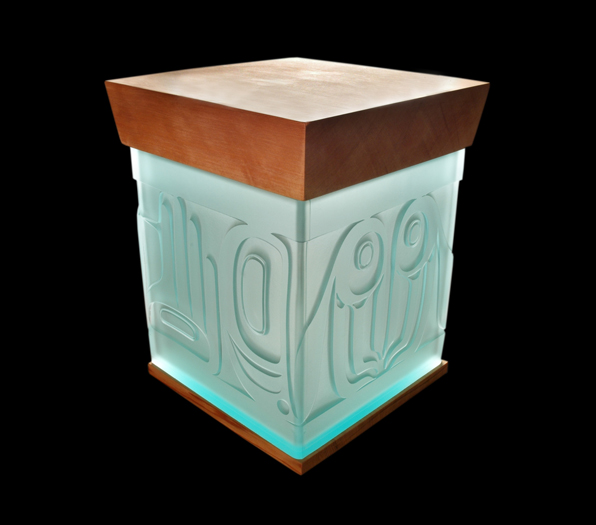 Land Otter BoxSandblasted Glass, Red Cedar
Land Otter BoxSandblasted Glass, Red Cedar- 15"h
- 10.25"w
- 10.25"d
SOLD -
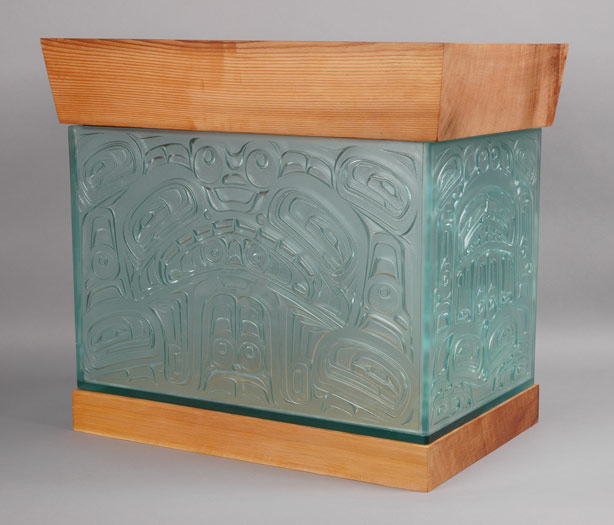 Sea Monster ChestSandblasted Glass, Red Cedar
Sea Monster ChestSandblasted Glass, Red Cedar- 17"h
- 21"w
- 14"d
SOLD -
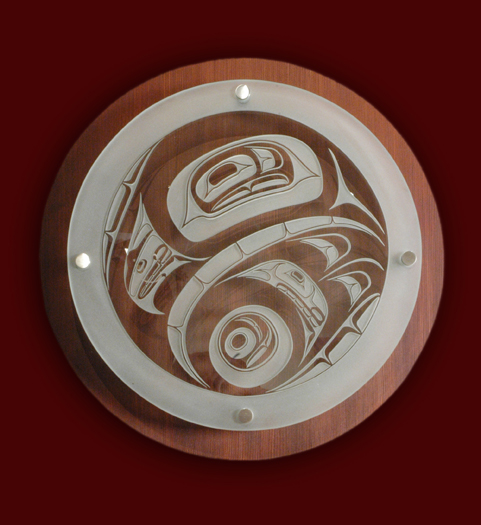 Eagle Transformation PanelSandblasted Glass, Red Cedar, Stainless Steel Standoffs
Eagle Transformation PanelSandblasted Glass, Red Cedar, Stainless Steel Standoffs- 21"h
- 21"w
- 3"d
SOLD -
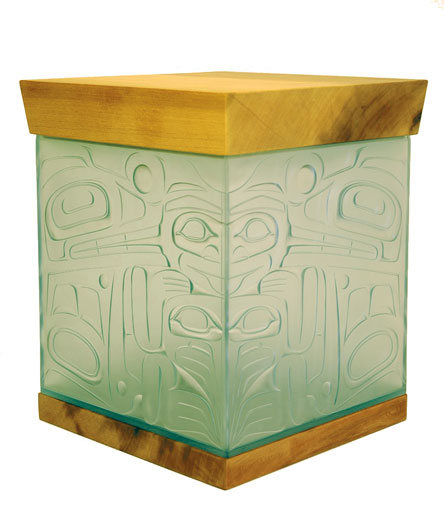 Raven and the BearRed Cedar, Glass
Raven and the BearRed Cedar, Glass- 22"h
- 17"w
- 17"d
SOLD -
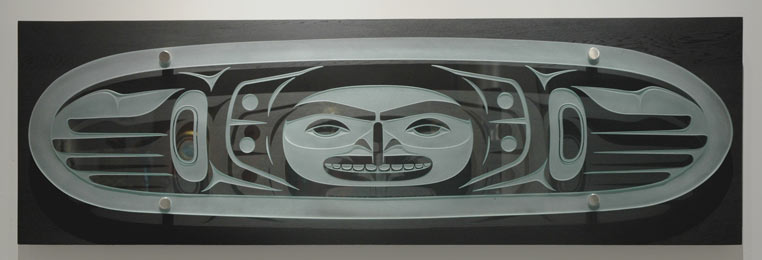 Traveling the StikineSandblasted Glass, Red Cedar, Acrylic, Stainless Steel Standoffs
Traveling the StikineSandblasted Glass, Red Cedar, Acrylic, Stainless Steel Standoffs- 15"h
- 48"w
- 3.5"d
SOLD -
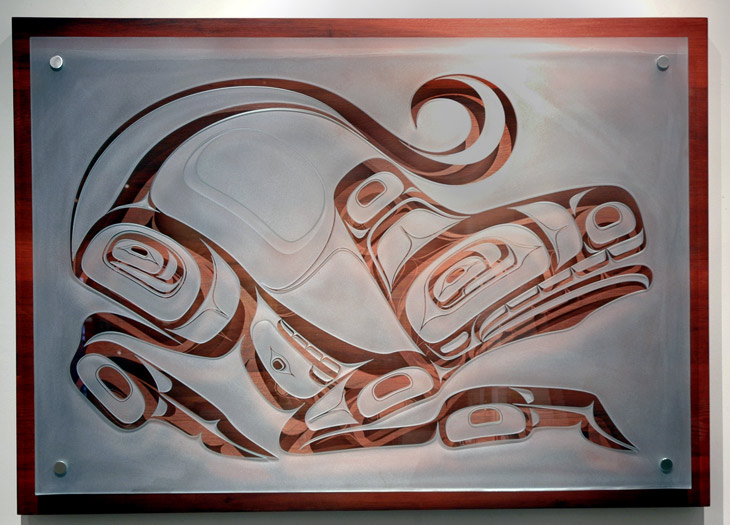 Cheona Alpha (Wolf)Sandblasted Glass, Red Cedar, Stainless Steel Standoffs
Cheona Alpha (Wolf)Sandblasted Glass, Red Cedar, Stainless Steel Standoffs- 40"h
- 42"w
- 3.5"d
SOLD -
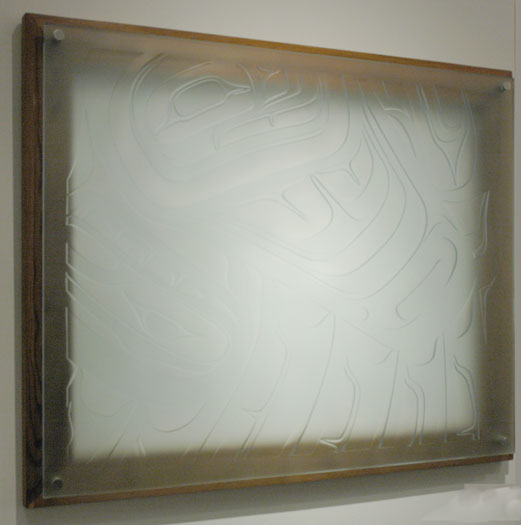 Thinking Like a RavenSandblasted Glass, Red Cedar
Thinking Like a RavenSandblasted Glass, Red Cedar- 35"h
- 45"w
- 3.5"d
SOLD -
 The HuntLimited Edition Sandblasted Glass, Plywood, Acrylic, Stainless Steel Standoffs
The HuntLimited Edition Sandblasted Glass, Plywood, Acrylic, Stainless Steel Standoffs- 30"h
- 30"w
- 3"d
SOLD -
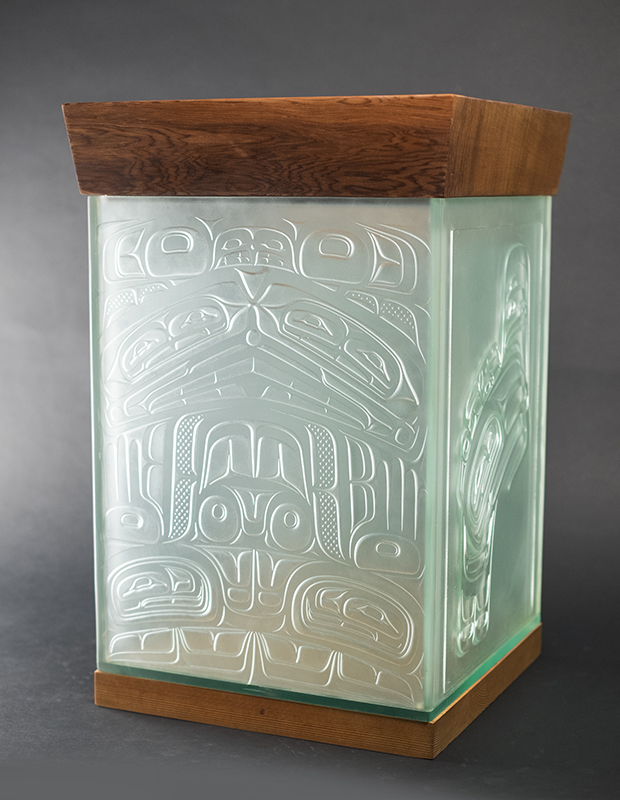 Sea Monster BoxSandblasted Glass, Red Cedar
Sea Monster BoxSandblasted Glass, Red Cedar- 26"h
- 16.50"w
- 16.50"d
SOLD -
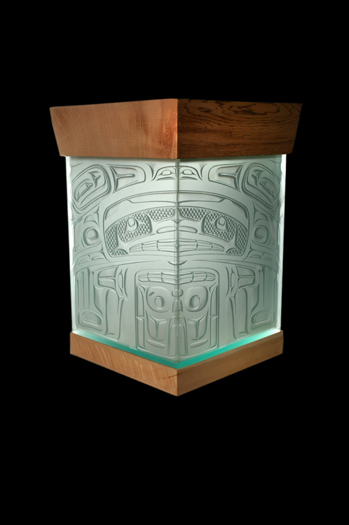 The House of the Mouse BoxSandblasted Glass, Red Cedar
The House of the Mouse BoxSandblasted Glass, Red Cedar- 18.5"h
- 13"w
- 13"d
SOLD
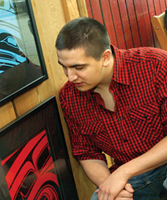
The Tahltan nation is located in the North West corner of British Columbia, Canada, and is the largest traditional territory in the province. Tahltan culture reflects a mix of both Athabascan and Coastal traditions. They have two clans: Tsesk’iye (Raven clan) and Ch’iyone (Wolf clan). Alano Edzerza belongs to the Raven clan and feels a deep connection to the Tahltan creation story featuring the Raven.
He has been an artist since he could hold a pencil and received a sculpture award at the age of thirteen from the school board of Victoria. This early talent developed rapidly into a professional career with pieces being sold internationally. Edzerza began working in Northwest Coast art under the tutelage of his family member, fellow Tahltan artist, Terrence Campbell.
In 2002 Edzerza furthered his education by attending school in Arizona for jewelry making under the instruction of Rick Charlie. He has also had the opportunity to work with artists Jay Simeon, Marcel Russ, Philip Gray, Corey Bulpitt, Beau Dick, Mark Preston and Dempsey Bob.
Edzerza was given his first solo show by Stonington Gallery in 2007. In 2010 he was commissioned by the Vancouver Olympic Committee to create a large scale glass installation at Rogers Arena. ASICS and the Dutch Olympic Team contracted him to help design their uniforms for the 2010 Olympic Winter Games. Since then Alano has been involved in many commissions, including law firms and development projects on traditional native land.
Edzerza has taught and volunteered with the youth organizations KAYA (Knowledgeable Aboriginal Youth Association), the Freida Diesing School for Northwest Coast Native Art, and NYAC (Native Youth Arts Collective) as well as been a judge for the YVR Art Foundation Scholarship for young Native artists. In 2009 he was the recipient of the 2009 30 & Under Entrepreneur of the Year Award.
If you were to walk around, two hundred years ago, from California to Alaska you would see, wear and live Northwest Coast art and Culture. I want to be a part of the movement that will allow this to happen once again.
Peoples of the Northwest Coast did not develop a written language, they developed an art form to tell the stories of our histories. This art form developed into one of the most advanced art forms in the world. This is also what makes this art so beautiful. The ways that balance is used within the formline. When you look at a piece your eye subconsciously continues to move studying the design because one shape flows into the next using variation of curves and thicknesses. This is the art of a once-dying culture. It’s the art that is bringing the culture back alive. This is the reason why I work so hard towards my goal.
-Alano Edzerza
